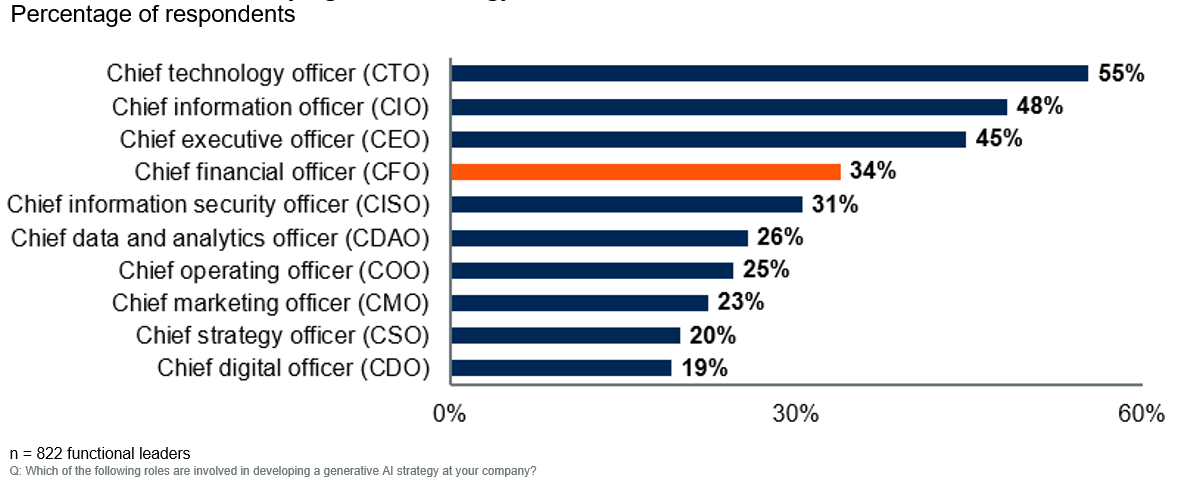A third of CFOs are involved in developing an enterprise GenAI strategy
In a recent survey conducted by Gartner, Chief Financial Officers (CFOs) are emerging as pivotal figures in the formulation of generative AI (GenAI) strategies within enterprises, highlighting the expanding role of financial leaders in the digital transformation landscape.
The survey further delineated the hierarchy of involvement among top executives, with the Chief Technology Officer (CTO) leading the pack as 55% of respondents cited their engagement in GenAI strategy efforts. This was closely followed by the Chief Information Officer (CIO) with 48%, and the Chief Executive Officer (CEO) with 45%, indicating a comprehensive leadership approach to embracing GenAI technologies.
“The large majority of CFOs continue to be displeased with the performance of digital investments across their organization,” said Alexander Bant, chief of research in the Gartner Finance practice.
“GenAI spend is expected to be five to eight times higher than last year at most organizations, and many CFOs are playing the role of copilot to ensure these investments drive measurable benefits and profitable growth without unduly increasing risk.”
Figure 1: CFOs’ involvement in Developing Enterprise GenAI Strategy

“CFOs know that GenAI strategies must be cross-functional. They are leaning in with their CIOs, CISOs, and CDAOs. But many are going further than just partnership, and instead playing a leadership role in crafting a GenAI strategy that aligns with and enhances the business and financial strategy for the board, investors, and regulators.” said Bant.
“They must foster discussions that are going to ensure cost-effective and responsible deployment of GenAI.”
To help CFOs navigate this trend, Gartner experts have identified three likely stages of GenAI deployment in enterprises: Defend, Extend and Upend.
The defend stage is where organizations must pick the low hanging fruit offered by GenAI and develop proper governance and employee understanding on responsible use of the technology.
This should involve implementing tools with low barriers to adoption and finding quick wins with specific tasks. For example, providing employee access to productivity assistants, such as Microsoft Copilot and Google Workspace, so GenAI can be applied to relevant workstreams in a sanctioned and controlled way.
“Even though these kinds of tools may seem quite revolutionary, the low barrier to adopting them means they will quickly become table stakes for doing business,” said Bant. “They will not give an organization a sustainable competitive advantage.”
The extend phase will cost more but will also have greater potential returns. This is where an organization would invest in more customized applications of GenAI technology, tailored to its unique circumstances of value proposition.
For example, GenAI could possibly augment the capabilities of financial advisors in wealth management. This has the potential to extend a service currently only within reach of the wealthiest individuals, providing it to a mass market audience.
The final scenario is one where GenAI upends an organization and disrupts its entire industry.
“This is the game-changing stuff that can get very expensive, very fast,” Bant told attendees. “But it also comes with much higher potential rewards.”
This is likely to involve shifts in employee productivity or business efficiency so profound that they lead to new products, services, and markets alongside new competitors in a similar way that tech giants have disrupted adjacent markets in recent years.
This content was adapted from the session “How CFOs Must Navigate Enterprise Generative AI” at the CFO & Finance Executive Conference in Sydney. Nonclients can watch the webinar “Unlock the Future of Finance with AI.”